Scientific name: Rhus trilobata var. trilobata
Common names: three-leaf sumac, skunk bush, squaw bush, lemonade bush, basket bush
Family: Anacardiaceae – Sumac
by Jeanne Gozigian
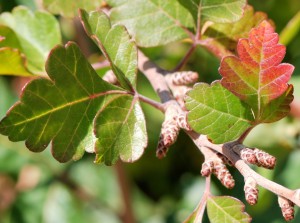
Shape and changing colors of leaves. Photo: Janice Tucker
Rhus trilobata, or three-leaf sumac, is an aromatic deciduous shrub that occurs in many plant communities from Alberta and Saskatchewan through the western states and the Great Plains of Texas to Baja California. It is hardy in zones 4-8. It is typically 6-10 feet wide and tall, is happy in many soil types and can live many years. Of the many plant communities where it can flourish, one is the middle to southern Rocky Mountain range, a juniper/pinion woodland such as we have at the Leonora Curtin Wetland Preserve (LCWP). Of course, the anomaly is that we have no pinones at LCWP although they should, logically, be there.
At the Preserve, associated plants include the grasses: western wheat grass, muhly, and grama grasses, among others. Ground cherry and shrubs like wolfberry, golden currant, rabbit brushes and snakeweed are present, as well as many one-seed juniper trees. In mountainous sites, Rhus trilobata would have Gambel oak, chokecherry, and true mountain mahogany as neighbors.
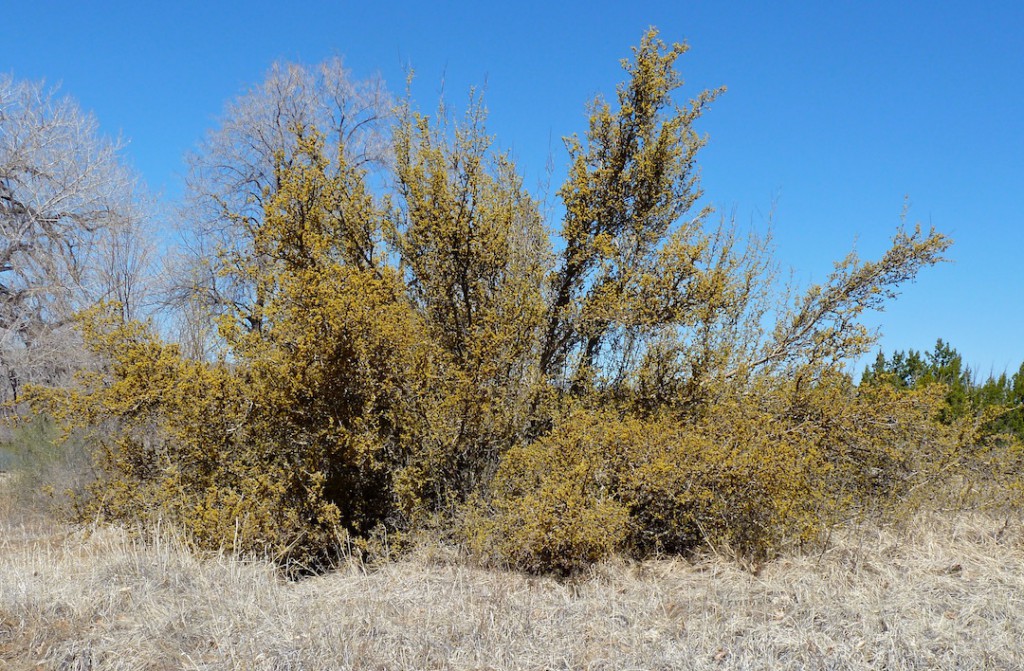
Three-leaf sumac covered with spring flowers at Leonora Curtin Wetland Preserve. Photo: Janice Tucker
Three-leaf sumac has low seed production and is physiologically dormant. It is very susceptible to damping off virus. Nonetheless, it is commercially available to purchase from some nurseries. It does well in disturbed sites with full sun to partial shade. It is a true survivor in case of wild fire; the top can be killed but sprouts pop from the root crown. It is browsed by big game and small mammals like porcupines and rabbits. Excellent winter food is provided for songbirds, turkeys, pheasants and quails. Bears and deer are also at the table. Large stands can be good for windbreaks and screening.
Rhus is the Greek name for sumac; that is, one species, the staghorn sumac. It has now come to encompass many plants. Rhus glabra, or smooth sumac, also has tart berries that can be made into lemonade. Al Schneider of Southwest Colorado Wildflowers (swcoloradowildflowers.com) says that the correct name for Rhus trilobata is Rhus aromatica, (syn. Rhus trilobata). My research, however, indicates that Rhus aromatica is another Rhus species that is native to eastern North America.
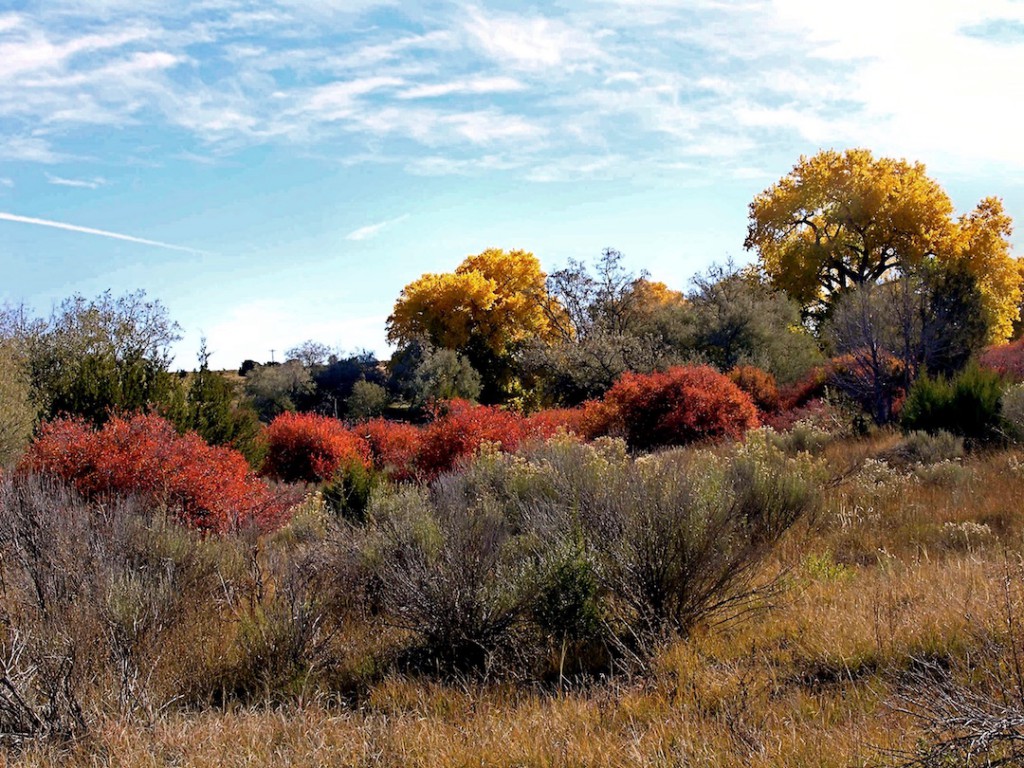
Autumn colors at Leonora Curtin Wetland Preserve (three-leaf sumacs in red). Photo: Janice Tucker
Three-leaf sumac was first collected in the eighteenth century from the Carolinas (perhaps this was Rhus aromatica) by the famous American gardener, John Bartram, to introduce English and European gardens to the fascinating plants from the “New World”. It is one of the very early bloomers, in March or early April, producing clusters of tiny yellow flowers that become red
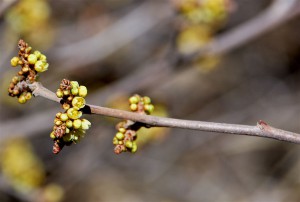
Close-up of the early spring flowers. Photo: Janice Tucker
tart berries in summer. It has trifoliate (three lobed) leaves, resembling those of currants, and they occur alternately on the branches. The green, slightly serrated leaves turn a brilliant red, burgundy, or orange color in the fall. When the leaves or stems are crushed they are pungently aromatic, hence one of the common names, skunk bush. Trees of this same family produce cashews, pistachio nuts and mangoes.
Another of the common names is lemonade bush. The tart red berries can be used to make a refreshing beverage. The interesting site, pennilessparenting.com, which features recipes using foraged ingredients, has directions for making sumac lemonade. Like many of your grandma’s recipes, it has no stated amounts:
Sumac Lemonade recipe
Make sumac juice by soaking ripe or dried berries in cold water for 10 or more minutes. Mash with a potato masher and let sit for ½ hour or so. Pour into cheesecloth and squeeze to separate juice and solids. Dilute to the strength you desire (by this time you will have very red hands, testifying to the fact that these berries were used for dyes and cosmetics – luscious red lips!).
Sweeten with sugar, stevia or honey. Add crushed mint, if desired, chill, and serve iced.
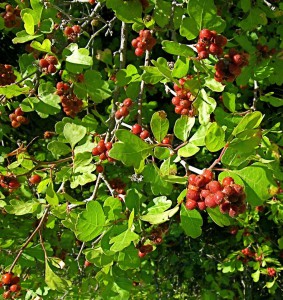
Red, tart berries of three-leaf sumac. Photo: Janice Tucker
The berries can also be mixed with cornmeal for porridge and added to dried meat and fats for pemmican, the ultimate trail food. While the berries are very tart, popping one into the mouth and rolling it around while on a summer hike, quenches thirst.
Two other common names, squaw bush and basket bush, attest to the fact that Native Americans used the twigs and branches to make baskets, particularly the Zuni and Navajo. As is often the case, ingenious uses of plant material were developed by experimentation. The leaves of three-leaf sumac are rich with tannic and gallic acids. They were dried and smoked and then used as a tobacco substitute.
As with many other native plants, diverse medicinal uses were found. Chewing bark was thought to be a cold remedy and oral aid for toothache. Gastrointestinal ills were also eased by bark chewing. Application of a fruit paste was deemed to prevent hair loss. Contraceptive aid was achieved by boiling the leaves to make a tea. It is not related to poison sumac, so does not cause skin irritation. But, as we always say, “Don’t try this at home!”.
Do visit the Leonora Curtin Wetland Preserve from early spring through fall, to see Rhus trilobata var. trilobata in its various stages of glory. It is also at the Museum Hill Garden along the Art Trail.
Many thanks to Janice Tucker for her beautiful photos of the seasons of three-leaf sumac. And to Janice and Helen Woody for proofreading this article.
Sources:
High Country Gardens, www.highcountrygardens.com/Rhus trilobata
Founding Gardeners by Andrea Wulf
Lady Bird Johnson Wildflower Center, www.califlora.org?cgi-bin/species_query.cgi?where-calrecnum+7092
Medicinal Plants of the Southwest, medplant.nmsu.edu
www.pennilessparenting.com, for foraging recipes
Santa Fe Botanical Garden Plant Database, santafebotanicalgarden.org
SEINet, http://swbiodiversity.org/seinet/index.php
Shrubs and Trees of the Southwest Uplands, by Francis H. Elmore
Stearn’s Dictionary of Plant Names for Gardeners, William T. Stearn
swcoloradowildflowers.com
The Plant List, theplantlist.org


